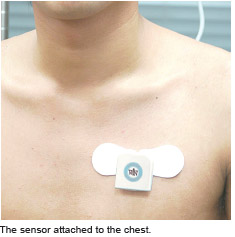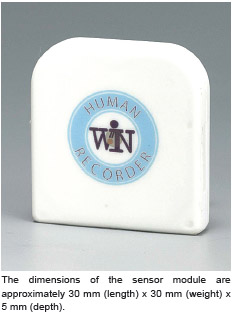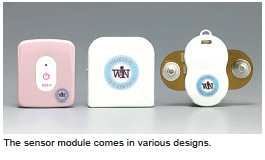Shinichi Kato, Tech-On!

JAPAN-WiN Human Recorder Co. Ltd., a Japan-based venture firm, launched a health monitoring service that uses a sensor network. In the service, health-related information is collected and analysed by a small sensor attached to a human body, and it is viewed and managed on a mobile phone or a PC. The company commercialised the health monitoring system, which is called "human recorder system", based on the research results of the Advanced Institute of Wearable Information Networks (WIN), a nonprofit organisation established by researchers at the University of Tokyo. WIN is a group led by Kiyoshi Itao, professor emeritus at the university.


The sensor is used to measure electrocardiographic signals, heart rate, brain waves, accelerated velocity, body temperature, respiration, pulse wave, etc. WIN helped develop, for example, a program to analyse each data and determine health condition. x 30 mm (weight) x 5 mm (depth) and 7 g, respectively. Because of the small size and the light weight, the module does not give uncomfortable feeling when attached to a human body. The sensor module has a 2.4 GHz wireless communication function and can be continuously operated for 3 to 4 days with a CR2032 button battery. Because the obtained data can be wirelessly transmitted to a PC or a mobile phone, it is possible to monitor the health condition of an elderly person who lives alone in a remote place via the Internet. For example, stress level can be measured based on the state of autonomic nerves determined from an electrocardiogram, and the fluctuation of heartbeat period can be analysed. The expected users of the HRS-I are companies that provide health monitoring services. The pricing of the service is more than ?0,000 (approximately US$111) per This time, WIN Human Recorder released the "HRS-I", a system that measures electrocardiographic signals, body surface temperature and human movements at the same time by attaching a sensor with wireless communication capability to the chest and determines health condition by using the software. Human movements are detected by a three-axis acceleration sensor. The dimensions and weight of the sensor module are approximately 30 mm (length) month for the rental of the software and more than ?0,000 for the purchase of the sensor. Marubeni Information Systems Co., Ltd., a sales agent for the HRS-I, aims at sales of about ¥1 billion in a year after the release of the system and about ¥5 billion after 3 years.(the end) As published online in Tech On! (
http://techon.nikkeibp.co.jp)
Air Jordan XI 11 High JAPAN-WiN Human Recorder Co. Ltd., a Japan-based venture firm, launched a health monitoring service that uses a sensor network. In the service, health-related information is collected and analysed by a small sensor attached to a human body, and it is viewed and managed on a mobile phone or a PC. The company commercialised the health monitoring system, which is called "human recorder system", based on the research results of the Advanced Institute of Wearable Information Networks (WIN), a nonprofit organisation established by researchers at the University of Tokyo. WIN is a group led by Kiyoshi Itao, professor emeritus at the university.
JAPAN-WiN Human Recorder Co. Ltd., a Japan-based venture firm, launched a health monitoring service that uses a sensor network. In the service, health-related information is collected and analysed by a small sensor attached to a human body, and it is viewed and managed on a mobile phone or a PC. The company commercialised the health monitoring system, which is called "human recorder system", based on the research results of the Advanced Institute of Wearable Information Networks (WIN), a nonprofit organisation established by researchers at the University of Tokyo. WIN is a group led by Kiyoshi Itao, professor emeritus at the university. 
 The sensor is used to measure electrocardiographic signals, heart rate, brain waves, accelerated velocity, body temperature, respiration, pulse wave, etc. WIN helped develop, for example, a program to analyse each data and determine health condition. x 30 mm (weight) x 5 mm (depth) and 7 g, respectively. Because of the small size and the light weight, the module does not give uncomfortable feeling when attached to a human body. The sensor module has a 2.4 GHz wireless communication function and can be continuously operated for 3 to 4 days with a CR2032 button battery. Because the obtained data can be wirelessly transmitted to a PC or a mobile phone, it is possible to monitor the health condition of an elderly person who lives alone in a remote place via the Internet. For example, stress level can be measured based on the state of autonomic nerves determined from an electrocardiogram, and the fluctuation of heartbeat period can be analysed. The expected users of the HRS-I are companies that provide health monitoring services. The pricing of the service is more than ?0,000 (approximately US$111) per This time, WIN Human Recorder released the "HRS-I", a system that measures electrocardiographic signals, body surface temperature and human movements at the same time by attaching a sensor with wireless communication capability to the chest and determines health condition by using the software. Human movements are detected by a three-axis acceleration sensor. The dimensions and weight of the sensor module are approximately 30 mm (length) month for the rental of the software and more than ?0,000 for the purchase of the sensor. Marubeni Information Systems Co., Ltd., a sales agent for the HRS-I, aims at sales of about ¥1 billion in a year after the release of the system and about ¥5 billion after 3 years.(the end) As published online in Tech On! (http://techon.nikkeibp.co.jp)Air Jordan XI 11 High
The sensor is used to measure electrocardiographic signals, heart rate, brain waves, accelerated velocity, body temperature, respiration, pulse wave, etc. WIN helped develop, for example, a program to analyse each data and determine health condition. x 30 mm (weight) x 5 mm (depth) and 7 g, respectively. Because of the small size and the light weight, the module does not give uncomfortable feeling when attached to a human body. The sensor module has a 2.4 GHz wireless communication function and can be continuously operated for 3 to 4 days with a CR2032 button battery. Because the obtained data can be wirelessly transmitted to a PC or a mobile phone, it is possible to monitor the health condition of an elderly person who lives alone in a remote place via the Internet. For example, stress level can be measured based on the state of autonomic nerves determined from an electrocardiogram, and the fluctuation of heartbeat period can be analysed. The expected users of the HRS-I are companies that provide health monitoring services. The pricing of the service is more than ?0,000 (approximately US$111) per This time, WIN Human Recorder released the "HRS-I", a system that measures electrocardiographic signals, body surface temperature and human movements at the same time by attaching a sensor with wireless communication capability to the chest and determines health condition by using the software. Human movements are detected by a three-axis acceleration sensor. The dimensions and weight of the sensor module are approximately 30 mm (length) month for the rental of the software and more than ?0,000 for the purchase of the sensor. Marubeni Information Systems Co., Ltd., a sales agent for the HRS-I, aims at sales of about ¥1 billion in a year after the release of the system and about ¥5 billion after 3 years.(the end) As published online in Tech On! (http://techon.nikkeibp.co.jp)Air Jordan XI 11 High
 iConnectHub
iConnectHub
 Login/Register
Login/Register Supplier Login
Supplier Login


























